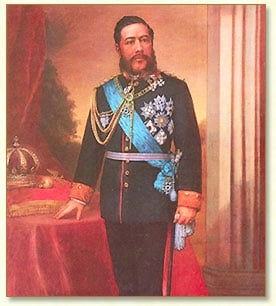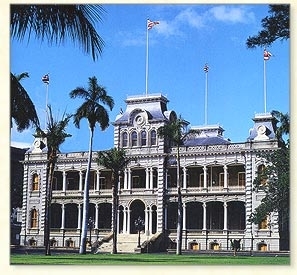 |
| King Kalakaua (Painting by William Cogswell) (http://www.iolanipalace.org/) |
David Kalakaua was born on November 16, 1836, and as was Hawaiian custom he was adopted by the chiefess, Haaheo Kanui, who took him to the court of King Kamehameha III on the island of Maui. When he was four he returned to Oahu to begin his education at the Royal School. He was fluent in English and Hawaiian and began studying law at the age of 16 but was unable to fully complete his legal training because of the various government positions he held.
When Kamehameha V died in December 1872 he had not designated an heir so an election was held to determine his successor. Prince William Charles Lunalilo was victorious over David Kalakaua by a wide margin. But on February 3, 1874 Lunalilo died without naming a successor so another election was held, and Kalakaua beat Queen Emma, the widow of Kamehameha V. King Kalakaua traveled to the United States and negotiated the Reciprocity of Treaty of 1875, which eliminated the tariff on sugar and other Hawaiian products and as a result, Hawaii’s sugar industry boomed and the kingdom enjoyed a period of economic prosperity.
When Kalakaua returned he moved into his palace with his wife, Queen Kapiolani. He decided he needed a more luxurious home, however, and had Iolani Palace built at a cost of $350,000 which was an unheard of sum at the time. Iolani Palace is the only royal palace that exists on American soil today. He named his brother, William Pitt Leleiohoku, as his heir, putting an end to the era of elected kings and also started off his reign with a tour of the Hawaiian island which improved his popularity. At one point his took a trip around the world to study the matter of immigration and to improve foreign relations, but he also wanted to study how other rulers ruled.
 |
| Iolani Palace (http://www.iolanipalace.org) |
By 1887, the Missionary party had grown very frustrated with Kalakaua and blamed him for the Kingdom’s growing debt and accused him of being a spendthrift. Some wanted to put his sister Lili’oukalani on the throne while others wanted to end the monarchy altogether and annex the island to the United States. Those who favored the annexation formed a group called the Hawaiian League and these members assembled together, armed with guns. Kalakaua was frightened by this show of force and offered to transfer his powers to the foreign ministers representing the United States, the United Kingdom, or Portugal. The members of the Hawaiian League instead asked him to sign a new constitution, nicknamed the Bayonet Constitution of 1887, which removed much of the King’s executive power and deprived most native Hawaiians of their voting rights. The legislature was now able to override a veto by the King, and the King was no longer allowed to take action without approval of the cabinet.
King Kalakaua’s health began to fail by 1890 and under the advice of his physician he traveled to San Francisco. His health continued to worsen and died on January 20, 1891 at the Palace Hotel in San Francisco. His remains were returned to Honolulu aboard the American Cruiser, USS Charleston, but because he and his wife Queen Kapiolani did not have any children, his sister, Lili’oukalani succeeded him to the Hawaiian throne. King Kalakaua earned the nickname “the Merrie Monarch,” because of his love of joyful elements of life. Under his reign, the hula was revived, which had been banned by the missionaries in the 1820s after being deemed immoral. He also had a passion for music, dancing, parties, and the finest food and drinks.
Page created on 8/4/2013 11:54:19 AM
Last edited 8/6/2018 5:07:45 AM
